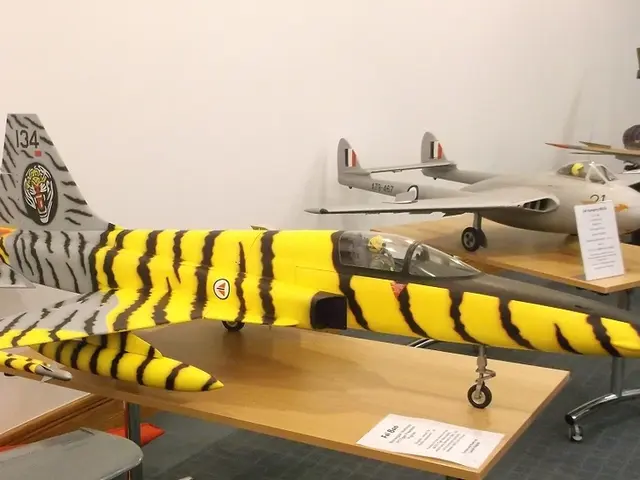Innovations in Technology Draw Inspiration from the Natural World: The Role of Nature in Shaping Modern Gadgets
Humans have long drawn inspiration from nature's wonders to drive innovation and solve complex problems. Animals, with their extraordinary adaptations and behaviors, have served as catalysts for many technological advancements throughout history. From the flight of birds to the silent glide of fish, nature has subtly and profoundly influenced the development of modern gadgets and technologies.
Biomimicry: Emulating Nature's Genius
Biomimicry, the science of mimicking biological entities and processes to create materials, structures, and systems, has been at the forefront of technological innovation. This approach unveils the boundless potential of nature-inspired technology in fostering sustainability, efficiency, and novel functionalities. By examining animals and their distinct adaptations, scientists and engineers craft solutions that harmonize with the environment, often leading to groundbreaking innovations.
Aviation: Birds Take Flight
For centuries, birds have inspired humans to conquer the skies. The Wright brothers, for example, studied the flight of pigeons to design the first successful airplane. Modern aviation continues to be influenced by birds, whose exceptional flight capabilities are emulated in various ways. The design of drones, for instance, often replicates the flapping wing motion of birds to improve maneuverability and efficiency. Additionally, morphing wings, mechanisms that change shape in response to air pressure, are inspired by the way birds adjust their wing shapes for different flight needs.
Aquatic Innovations: Sea Creatures Guide the Way
The ocean's rich biodiversity offers a wealth of inspiration for underwater technology. Sharks, with their streamlined bodies and rough skins, have inspired swimsuits and boat hulls designed to reduce drag, resulting in increased speed and efficiency. Submarines have also adopted the streamlined shapes of marine animals, such as dolphins, to enhance their movement through water. Furthermore, the silent and efficient propulsion methods of fish, particularly the oscillating tails of tunas and eels, serve as models for underwater robotics.
Insect Engineering and Robotics
Insects have left researchers bewildered by their complex behaviors and capabilities, given their diminutive size. Robotic engineers study insects like bees and ants to develop drones and robots that can navigate complex terrains and tasks efficiently. The intricate sensory systems of insects have also inspired advancements in sensors and microelectronics, paving the way for innovations such as miniaturized drones that mimic the flight mechanics of insects.
The Gecko's Grip: Adhesive Technologies Abound
The ability of the gecko to adhere to and traverse surfaces with ease has inspired numerous adhesive technologies. Geckos' footpads are covered in microscopic hairs that exploit van der Waals forces, allowing them to stick without leaving residue. Engineers have applied this principle to develop advanced adhesives capable of strong, reversible adhesion in various applications, from everyday use to industrial settings.
Nature-Inspired Materials
Nature has provided essential inspiration for the development of new materials. Spider silk, for example, boasts remarkable structural strength and flexibility, inspiring the creation of synthetic fibers for use in textiles and medical sutures. The lotus leaf, with its ability to self-clean due to its nanostructured surface, has influenced the creation of self-cleaning surfaces and water-repellent materials. These advancements in material science demonstrate the crucial role that animals play in pioneering innovative materials.
Sustainable and Eco-Friendly Designs
By examining nature's energy-efficient processes, technology not only advances but also becomes more sustainable. Eco-friendly technologies often draw directly from nature, harnessing passive cooling systems in buildings, such as those inspired by termite mounds, to significantly reduce energy consumption. This concept of biomimetic design can also be observed in architecture that harnesses natural light and airflow, minimizing reliance on artificial resources.
The Enduring Legacy of Nature's Lessons
Animals and the ecosystems they inhabit remain a rich source of insights into solving human challenges. As we venture further into an era of technological proliferation, the lessons learned from nature are not only propelling us forward but also reminding us of the importance of living in harmony with the environment. By continuing to study and emulate the remarkable abilities of the animal kingdom, we can create gadgets and technologies that are not only innovative but also sustainable and attuned to the world we live in.
*Data sourced from [Enrichment Data]:- Shark skin aerodynamics, reducing drag and improving fuel efficiency in airplanes (Delta Airlines, aerospace companies)- Kingfisher beak-inspired bullet trains reducing noise and air pressure spikes (Japan's Shinkansen bullet trains)- Aerodynamic improvements inspired by aerospace design in trucks (Volvo Trucks)- Shark skin texture, reducing drag in water and minimizing biofouling in boats and swimsuits- Animal-inspired morphing robots (Caltech's ATMO, bird morphology for obstacle avoidance)- Animal-like endurance in mobile robots (novel energy storage technologies inspired by animal physiology)- Velcro originating from the observation of how burr seeds stick to animal fur- Nature-inspired energy efficiency in designs reducing drag in vehicles and aircraft, thereby lowering fuel consumption and emissions- Bioinspired surface textures in maritime vessels, minimizing energy-consuming cleaning and maintenance.
- Biomimicry, working to mimic biological entities and processes, bolsters the creation of eco-friendly materials, structures, and systems, fostering greater sustainability and efficiency.
- Aviation has been significantly influenced by birds, as engineers study their flight capabilities to improve the maneuverability and efficiency of drones, emulating their flapping wing motion, and morphing wings, which change shape in response to air pressure, similarly to the way birds adjust their wing shapes.
- Insects, with complex behaviors and capabilities, have inspired the development of drones and robots capable of navigating complex terrains and tasks, adaptations based on the study of bees' and ants' behaviors, as well as advancements in sensors and microelectronics inspired by the intricate sensory systems of these insects.
- Material science innovations have been inspired by nature, with examples such as the creation of synthetic fibers for textiles and medical sutures using spider silk, and self-cleaning surfaces and water-repellent materials modeled after the lotus leaf's nanostructured surface.








